Bi-color tourmaline is a unique variety of the tourmaline family that exhibits two or more distinct colors within a single crystal. These colors can range from pink and green to blue and yellow, and the transition between colors can be either gradual or sharp. The coloration in bi-color tourmaline is due to variations in the trace elements such as iron, magnesium, and lithium within the crystal structure during its formation.
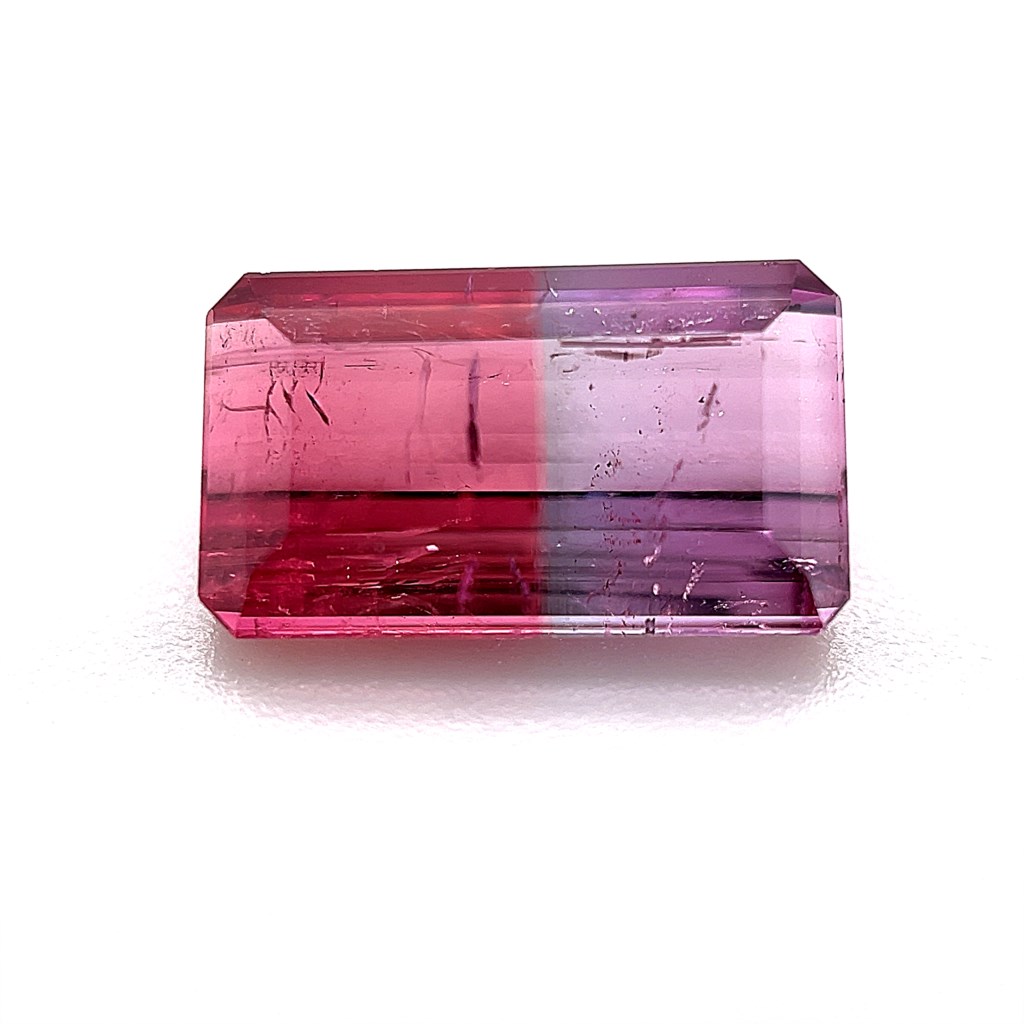
Key characteristics of bi-color tourmaline include:
- Hardness: It has a Mohs hardness of 7 to 7.5, making it durable for various types of jewelry.
- Crystal Structure: Tourmaline crystals are typically elongated and striated, forming in trigonal systems.
- Pleochroism: Tourmaline often displays strong pleochroism, showing different colors when viewed from different angles.
- Transparency: This gemstone can range from transparent to opaque, with transparent varieties being more valuable.
- Luster: It has a vitreous to resinous luster.
Historical Background and Discovery
The name “tourmaline” is derived from the Sinhalese words “turmali” or “toramalli,” which mean “mixed gems” or “stone with mixed colors.” Tourmaline has been known and used since ancient times, with records of its use dating back to the Roman period. However, it wasn’t until the late 1600s that tourmaline was recognized as a distinct mineral species.
The discovery of bi-color tourmaline specifically is attributed to various locations worldwide. Notably, Brazil has been a major source of high-quality bi-color tourmaline, especially from the state of Paraíba, known for its vibrant and unique colors. Other significant sources include Afghanistan, Nigeria, Mozambique, and the United States (California and Maine).
In the 18th and 19th centuries, tourmaline gained popularity in Europe, especially among the Russian and French aristocracy. The Empress of China, Dowager Cixi, was known to favor tourmaline, leading to increased demand and mining in the early 20th century.
Importance in the Gemstone Market
Bi-color tourmaline holds a special place in the gemstone market due to its unique and attractive color combinations, which make it highly sought after by collectors and jewelry designers. Its significance in the market can be attributed to several factors:
- Aesthetic Appeal: The natural beauty and intriguing color transitions of bi-color tourmaline make it a favorite among gem enthusiasts and designers.
- Rarity and Value: High-quality bi-color tourmaline is relatively rare, which increases its value. Stones with vivid, well-defined colors and good transparency are particularly prized.
- Versatility: Due to its hardness and range of colors, bi-color tourmaline is versatile and can be used in various types of jewelry, from rings and pendants to earrings and bracelets.
- Investment Potential: As a rare and beautiful gemstone, bi-color tourmaline can be a good investment. Its value has been known to appreciate over time, especially for stones from famous localities like Paraíba.
- Symbolism and Healing: Tourmaline is believed to have various metaphysical properties, such as promoting emotional healing and protecting against negative energies. This adds to its allure for those interested in the holistic and spiritual aspects of gemstones.
In conclusion, bi-color tourmaline is a fascinating and valuable gemstone that has captivated humans for centuries. Its unique color patterns, historical significance, and market value make it a standout choice for both collectors and jewelry enthusiasts
Formation and Geological Occurrence of Bi-color Tourmaline
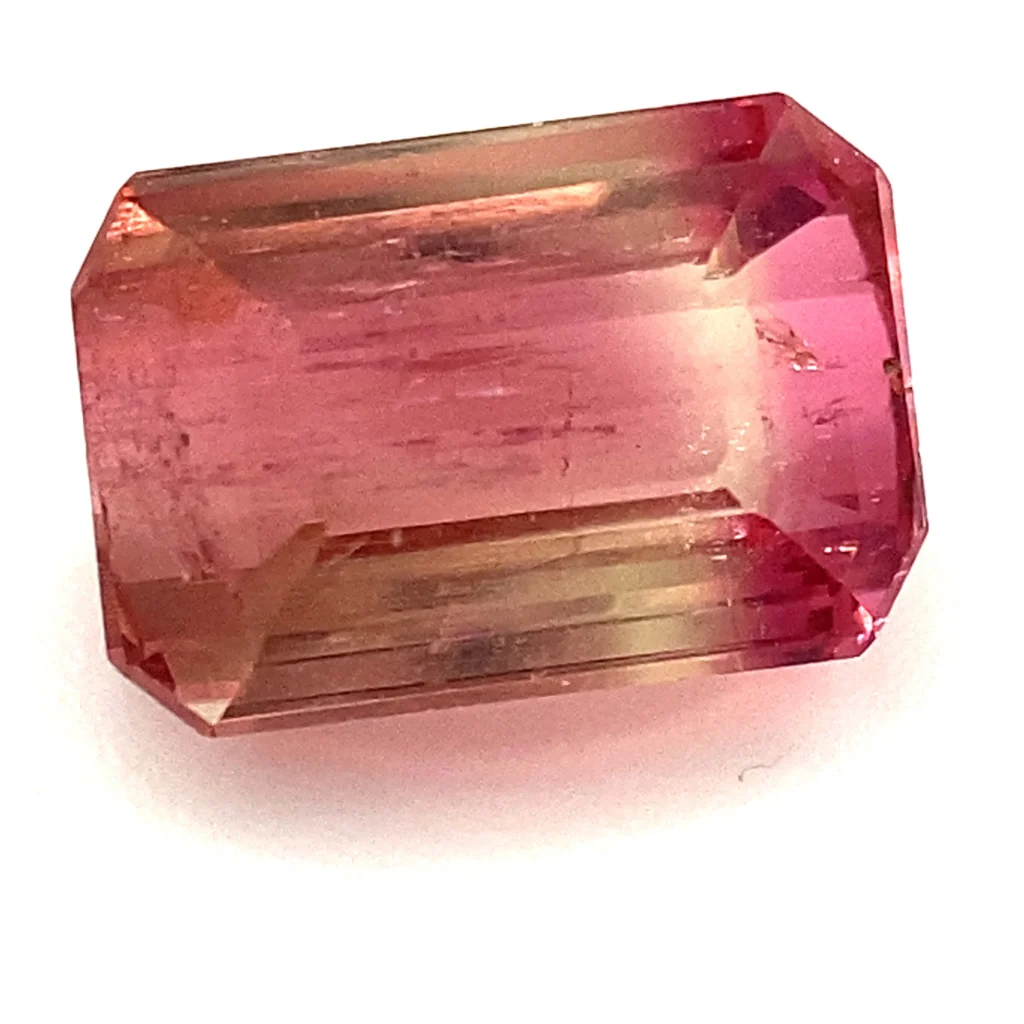
Formation
Bi-color tourmaline, like other types of tourmaline, forms under specific geological conditions that involve a complex interplay of temperature, pressure, and chemical environment. The formation process can be summarized as follows:
- Pegmatitic Origin: Most tourmalines, including bi-color varieties, are formed in igneous rocks known as pegmatites. Pegmatites are coarse-grained granitic rocks that crystallize from molten magma deep within the Earth’s crust.
- Chemical Composition: The magma that forms pegmatites is rich in volatile components like water, boron, and various metal ions (e.g., lithium, iron, manganese). These elements are crucial for the formation of tourmaline.
- Crystallization Process: As the magma cools, it starts to crystallize. The presence of boron in the magma facilitates the formation of tourmaline crystals. The color variations in bi-color tourmaline are caused by changes in the chemical composition of the magma during the crystallization process. For example, an increase in iron or manganese content can change the color from pink to green or blue.
- Zoning: The bi-color effect occurs due to zoning within the crystal. Zoning happens when different layers of the crystal form under varying chemical conditions. This can result in distinct color bands within a single crystal, creating the bi-color effect. The boundaries between different color zones can be sharp or gradual.
Geological Occurrence
Bi-color tourmaline can be found in several geological settings around the world. The primary sources are pegmatite deposits, but they can also be found in metamorphic rocks and alluvial deposits. Significant occurrences include:
- Brazil: Brazil is one of the most famous sources of high-quality bi-color tourmaline, particularly in the states of Minas Gerais and Paraíba. The Paraíba region is especially renowned for producing vibrant blue and green tourmalines with distinctive bi-color patterns.
- Afghanistan: The tourmaline mines in the Nuristan region of Afghanistan are known for producing beautiful bi-color tourmaline, often with pink and green hues. The crystals from this region are highly prized for their clarity and vivid colors.
- Nigeria: Nigeria is another important source of bi-color tourmaline, particularly in the states of Oyo and Ogun. Nigerian tourmalines often display striking color combinations and are sought after in the gemstone market.
- Mozambique: In recent years, Mozambique has emerged as a significant producer of high-quality tourmaline, including bi-color varieties. The deposits in the Alto Ligonha region are particularly notable.
- United States: The United States, particularly California and Maine, has a long history of producing bi-color tourmaline. The tourmalines from these regions are known for their rich colors and historical significance. The Himalaya Mine in California and the Mount Mica Mine in Maine are well-known sources.
- Madagascar: Madagascar is another location where bi-color tourmaline can be found. The deposits in the Ilakaka and Andranondambo regions produce tourmalines with a wide range of colors, including bi-color specimens.
Extraction and Processing
- Mining: Tourmaline is typically mined using both open-pit and underground mining methods, depending on the nature of the deposit. Pegmatite deposits are often mined using open-pit methods, while more complex underground networks may be used for deeper deposits.
- Sorting and Grading: Once extracted, the tourmaline crystals are sorted and graded based on their color, clarity, size, and overall quality. Bi-color tourmalines are especially prized and are often singled out for their unique visual appeal.
- Cutting and Polishing: Cutting bi-color tourmaline requires skill to maximize the color effect and ensure that the transition between colors is visually appealing. Skilled lapidaries cut the stones to enhance their natural beauty, often shaping them into faceted gems or cabochons.
In summary, bi-color tourmaline is a fascinating gemstone that forms under specific geological conditions in pegmatite deposits. Its unique bi-color appearance is the result of variations in the chemical environment during crystal growth. Found in several key locations around the world, bi-color tourmaline continues to captivate gem enthusiasts and collectors with its vibrant colors and distinctive patterns.
Types and Varieties of Bi-color Tourmaline

Bi-color tourmaline is admired for its unique color combinations, which can vary widely based on the specific conditions during its formation. Here are some common and rare bi-color variations:
Common Color Combinations
- Pink-Green (Watermelon Tourmaline):
- Description: This is one of the most popular and recognizable types of bi-color tourmaline. It typically features a pink center surrounded by a green outer layer, resembling a watermelon slice.
- Occurrence: Commonly found in Brazil, Afghanistan, and the United States (California and Maine).
- Blue-Green:
- Description: These tourmalines display a beautiful transition from blue to green, often referred to as “indicolite-green” when the blue is particularly vivid.
- Occurrence: Frequently sourced from Brazil, Nigeria, and Mozambique.
- Pink-Yellow:
- Description: This combination features a delicate blend of pink and yellow hues, creating a warm and appealing look.
- Occurrence: Found in Brazil and Afghanistan.
- Green-Yellow:
- Description: A harmonious blend of green and yellow shades, often exhibiting a gradual transition between the two colors.
- Occurrence: Common in Brazilian and African deposits.
- Blue-Pink:
- Description: This type showcases a striking contrast between blue and pink, making it highly attractive and sought after.
- Occurrence: Found in Brazil, Nigeria, and Mozambique.
Unique and Rare Bi-color Variations
- Paraíba Blue-Green:
- Description: Paraíba tourmalines are renowned for their intense neon blue and green colors. Bi-color Paraíba tourmalines with both colors in one crystal are extremely rare and highly valuable.
- Occurrence: Exclusively found in the Paraíba region of Brazil and some parts of Mozambique.
- Tricolor Tourmaline:
- Description: While not strictly bi-color, tricolor tourmaline features three distinct color zones within a single crystal. Common combinations include pink, green, and blue or pink, yellow, and green.
- Occurrence: Found in Brazil and Afghanistan.
- Purple-Blue:
- Description: This rare variation showcases a stunning blend of purple and blue hues, often with a smooth transition between the two colors.
- Occurrence: Rarely found, but when it does appear, it is usually from Brazil or Africa.
- Brown-Pink:
- Description: A unique and less common combination where brown transitions into pink, creating an earthy yet vibrant appearance.
- Occurrence: Occurs in Brazilian and African deposits.
- Black-Green (Verdelite-Schorl):
- Description: This combination features deep black (schorl) transitioning into green (verdelite), providing a striking contrast.
- Occurrence: Found in Brazil, Africa, and the United States.
- Yellow-Brown:
- Description: A rare and interesting combination where yellow blends with brown, often resulting in a golden-brown appearance.
- Occurrence: Typically found in Brazil and Madagascar.
Factors Influencing Color Combinations
- Chemical Composition: The presence of trace elements like iron, manganese, lithium, and copper significantly influences the colors in tourmaline.
- Geological Conditions: Variations in temperature and pressure during crystal formation can lead to different color zones within the same crystal.
- Inclusions and Impurities: Natural inclusions and impurities within the crystal can also affect its color and overall appearance.
In conclusion, bi-color tourmaline’s wide range of color combinations makes it a highly versatile and desirable gemstone. Whether common or rare, each piece of bi-color tourmaline is unique, offering a distinctive blend of nature’s artistry.
Physical and Chemical Properties of Bi-color Tourmaline
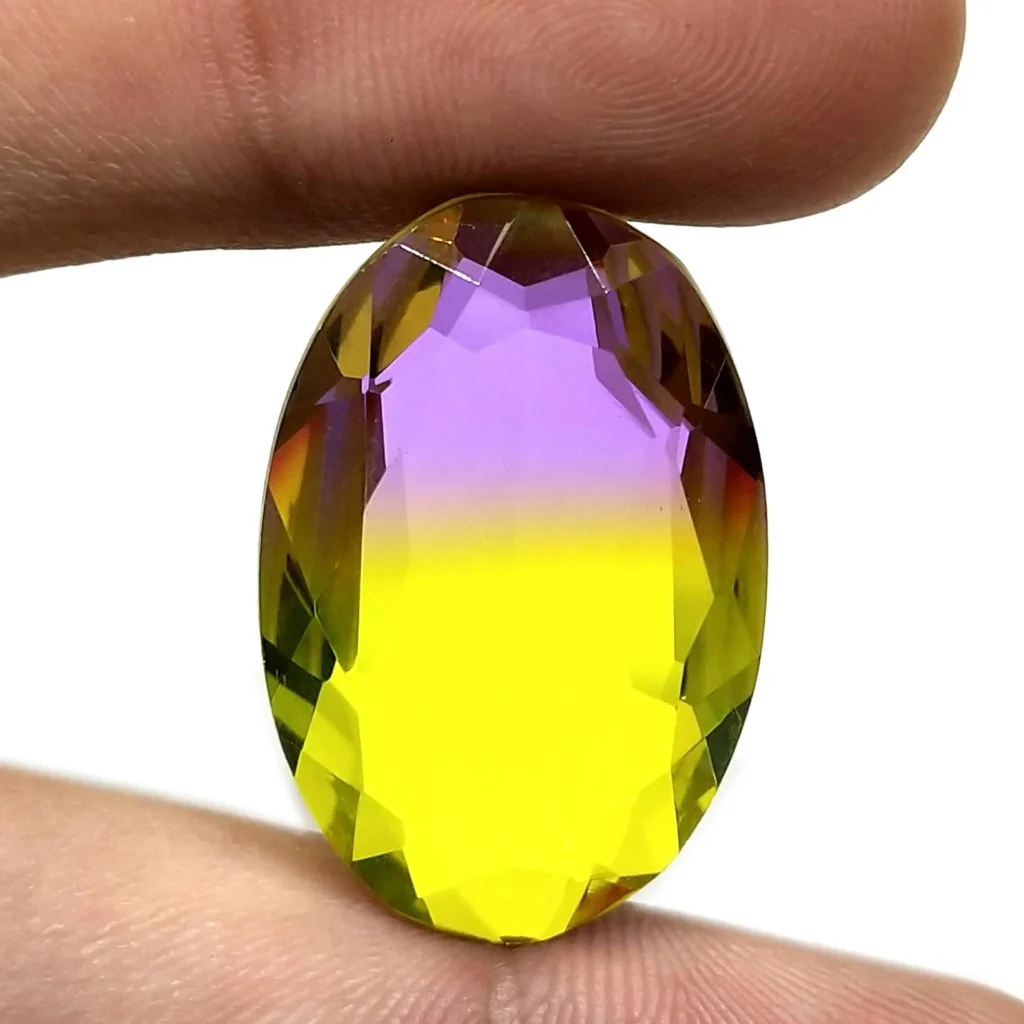
Physical Properties
- Crystal System: Trigonal
- Description: Tourmaline crystals belong to the trigonal crystal system, often forming elongated, prismatic crystals with vertical striations. The trigonal system is characterized by threefold symmetry.
- Hardness: 7 to 7.5 on the Mohs scale
- Description: Tourmaline is relatively hard, making it suitable for use in various types of jewelry. Its hardness ensures good durability and resistance to scratching.
- Luster: Vitreous to Resinous
- Description: Tourmaline typically exhibits a vitreous (glass-like) luster, although some specimens can have a resinous sheen.
- Transparency: Transparent to Opaque
- Description: The degree of transparency can vary significantly. High-quality bi-color tourmaline is usually transparent to translucent, enhancing its appeal as a gemstone.
- Cleavage: Indistinct
- Description: Tourmaline has poor to indistinct cleavage, meaning it does not break along well-defined planes. Instead, it tends to fracture in an uneven or conchoidal manner.
- Fracture: Conchoidal to Uneven
- Description: The fracture pattern is typically conchoidal (shell-like) to uneven, contributing to the stone’s overall toughness.
- Specific Gravity: 3.0 to 3.2
- Description: The specific gravity of tourmaline ranges from 3.0 to 3.2, indicating that it is denser than many other common minerals.
- Refractive Index: 1.614 to 1.666
- Description: Tourmaline has a relatively high refractive index, contributing to its brilliance and sparkle. The refractive index can vary slightly depending on the color and composition of the stone.
- Pleochroism: Strong
- Description: Tourmaline exhibits strong pleochroism, meaning it shows different colors when viewed from different angles. This optical property enhances its visual appeal, particularly in bi-color varieties.
Chemical Properties
- Chemical Formula: Complex borosilicate with variable composition
- General Formula: XY3Z6(BO3)3(Si6O18)(OH, F, O)4XY3Z6(BO3)3(Si6O18)(OH, F, O)4
- Description: Tourmaline’s chemical composition can vary widely, with X, Y, and Z representing different metal ions that can be present in the crystal structure. Common elements include sodium (Na), lithium (Li), calcium (Ca), iron (Fe), magnesium (Mg), manganese (Mn), and aluminum (Al).
- Color-Causing Elements:
- Iron (Fe): Contributes to green, blue, and brown colors.
- Manganese (Mn): Results in pink, red, and yellow hues.
- Chromium (Cr) and Vanadium (V): Can cause intense green colors.
- Lithium (Li): Often associated with a wide range of colors, including pink, red, and green.
- Copper (Cu): Responsible for the vivid blue and green colors seen in Paraíba tourmalines.
- Isomorphous Replacement: Tourmaline’s complex structure allows for isomorphous replacement, where one type of ion can replace another within the crystal lattice without significantly altering the structure. This flexibility in composition is why tourmaline can display such a wide range of colors and combinations.
- Stability: Tourmaline is chemically stable and resistant to weathering. It does not react easily with most chemicals, making it durable over geological timescales.
In summary, bi-color tourmaline is characterized by its trigonal crystal system, considerable hardness, vitreous luster, and strong pleochroism. Its complex chemical composition allows for a variety of color combinations, resulting in its unique and highly valued appearance. These physical and chemical properties contribute to its popularity and desirability as a gemstone.
Identification and Grading of Bi-color Tourmaline
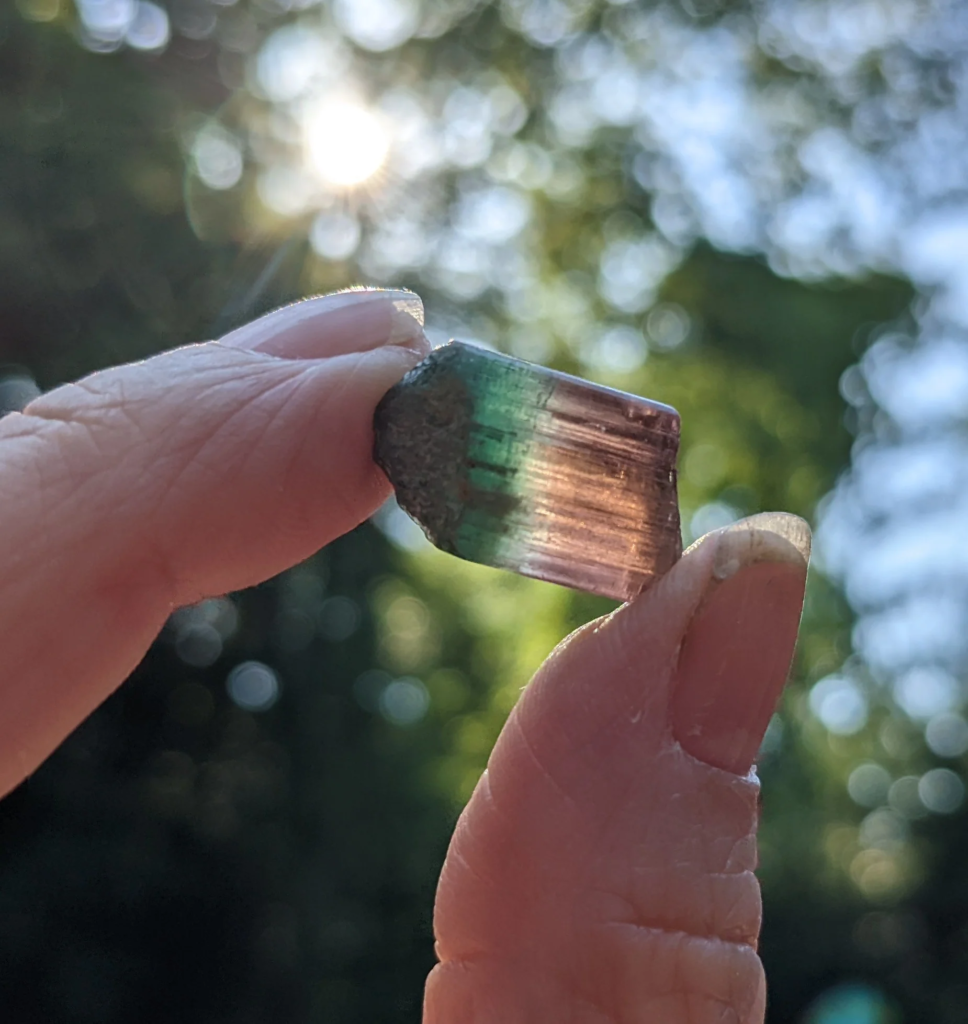
Identification
- Visual Examination:
- Color Zoning: Bi-color tourmaline can be identified by its distinct color zoning, where two or more colors are present within the same crystal. This zoning can be sharp or gradual.
- Crystal Shape: Tourmaline typically forms elongated, prismatic crystals with vertical striations.
- Physical Properties:
- Hardness: A Mohs hardness of 7 to 7.5 can help distinguish tourmaline from softer minerals.
- Luster: The vitreous luster of tourmaline is another identifying feature.
- Pleochroism: Strong pleochroism, where the stone shows different colors when viewed from different angles, is a key characteristic.
- Refractive Index:
- Measurement: Using a refractometer, tourmaline’s refractive index can be measured, typically falling between 1.614 and 1.666.
- Birefringence: Tourmaline has a birefringence of 0.014 to 0.040, which can be observed under polarized light.
- Specific Gravity:
- Measurement: The specific gravity of tourmaline ranges from 3.0 to 3.2, which can be determined using a hydrostatic balance.
- Spectroscopic Analysis:
- Absorption Spectrum: Tourmaline can exhibit characteristic absorption lines in the visible spectrum, which can be identified using a spectroscope.
Grading
- Color:
- Hue, Tone, and Saturation: The most important factor in grading bi-color tourmaline is its color. Stones with vibrant, well-defined, and balanced color zones are highly valued.
- Uniqueness: Rare color combinations and intense colors enhance the stone’s value.
- Clarity:
- Inclusions: Tourmaline often has inclusions, but the clarity is still an important grading factor. Eye-clean stones (those without visible inclusions) are more valuable.
- Type of Inclusions: Needle-like inclusions are common, but large or numerous inclusions can decrease the stone’s value.
- Cut:
- Quality of Cut: A well-cut tourmaline maximizes its color and brilliance. Proper cutting can enhance the stone’s visual appeal, especially in bi-color specimens where orientation of the cut can emphasize the color zones.
- Symmetry and Proportion: Symmetrical and proportionate cuts are preferred.
- Carat Weight:
- Size: Larger bi-color tourmalines are rarer and more valuable, especially if they exhibit high-quality color and clarity.
- Transparency:
- Level of Transparency: Transparent stones are generally more desirable than opaque ones, as they better display the bi-color effect.
Common Treatments and Enhancements
- Heat Treatment:
- Purpose: Heat treatment is used to enhance the color of tourmaline, often to lighten or deepen certain hues.
- Detection: This treatment can sometimes be detected by the presence of heat-induced inclusions or changes in the crystal structure under magnification.
- Irradiation:
- Purpose: Irradiation is used to change or enhance the color of tourmaline, particularly to intensify pink and red hues.
- Detection: While irradiation is harder to detect, specialized equipment and testing can sometimes reveal its use.
- Fracture Filling:
- Purpose: Fracture filling with resins or oils can improve the clarity of tourmaline by filling surface-reaching cracks and fissures.
- Detection: This treatment can often be detected under magnification, where filled fractures might show a flash effect or bubbles within the filling material.
- Surface Coating:
- Purpose: Surface coating with thin films can alter or enhance the color of tourmaline. This is less common but still a potential treatment.
- Detection: Coatings can often be detected under magnification or by using a gemological microscope, as they may show wear at facet edges or be unevenly applied.
- Laser Drilling:
- Purpose: Laser drilling is used to remove dark inclusions from tourmaline, thereby improving its clarity.
- Detection: Laser drill holes can be seen under magnification and appear as tiny, straight tunnels reaching into the stone.
Ethical Considerations
- Disclosure: It is essential for sellers to disclose any treatments that a bi-color tourmaline has undergone. This ensures transparency and maintains trust in the gemstone market.
- Certification: Having the stone certified by a reputable gemological laboratory can provide assurance about its authenticity and any treatments it may have received.
In summary, identifying and grading bi-color tourmaline involves examining its physical and optical properties, including color, clarity, cut, and transparency. Common treatments like heat treatment, irradiation, fracture filling, surface coating, and laser drilling are used to enhance its appearance, and ethical practices require full disclosure of such treatments.
Uses and Significance of Bi-color Tourmaline
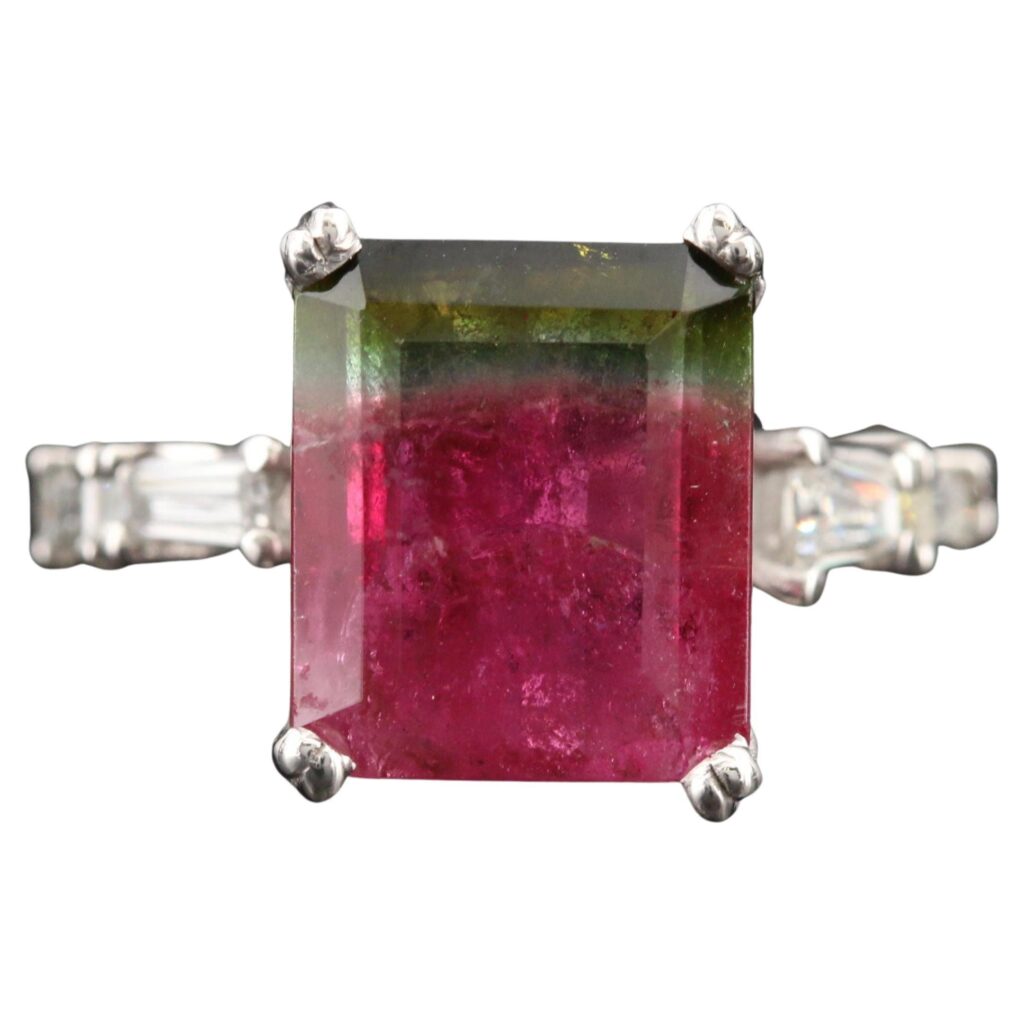
Uses
- Jewelry:
- Rings: Bi-color tourmaline is popular in rings, where its unique color zoning can be showcased. Engagement rings featuring bi-color tourmaline are particularly distinctive and valued for their uniqueness.
- Earrings: Earrings set with bi-color tourmaline can highlight the stone’s vibrant colors and pleochroism. Drop and stud earrings are common styles.
- Necklaces and Pendants: The elongated crystals of tourmaline are well-suited for pendants and necklaces. Bi-color tourmaline pendants often become statement pieces due to their striking appearance.
- Bracelets: Tourmaline’s durability makes it suitable for bracelets, where its colors can be arranged in patterns to create visually appealing designs.
- Collectibles:
- Specimens: Collectors value bi-color tourmaline specimens for their natural beauty and rarity. Well-formed crystals with distinct color zones are particularly sought after.
- Cabochons: In addition to faceted gems, bi-color tourmaline is often cut into cabochons to showcase its colors and patterns, making it a favorite among gem enthusiasts.
- Metaphysical and Healing Uses:
- Emotional Healing: Bi-color tourmaline is believed to promote emotional healing and balance. The pink and green varieties, often associated with the heart chakra, are thought to enhance love and compassion.
- Energy Protection: Tourmaline is considered a protective stone, helping to shield against negative energies and environmental pollutants.
- Balance and Harmony: The dual colors of bi-color tourmaline symbolize balance and harmony, making it a popular stone for meditation and spiritual practices.
- Decorative Arts:
- Artistic Carvings: Tourmaline, including bi-color varieties, is sometimes used for artistic carvings and sculptures. Its hardness and range of colors make it suitable for intricate designs.
Significance
- Symbolism:
- Harmony and Balance: The dual colors of bi-color tourmaline represent the balance between different energies and emotions. It is often seen as a stone of harmony.
- Transformation: The natural blending of colors within a single crystal symbolizes transformation and personal growth.
- Cultural and Historical Significance:
- Historical Popularity: Throughout history, tourmaline has been favored by various cultures. In the 19th century, it was highly prized by the Russian and French aristocracy.
- Cultural Beliefs: In many cultures, tourmaline is believed to have protective and healing properties. For example, in Chinese culture, it was believed to bring prosperity and attract good fortune.
- Economic Importance:
- Gemstone Market: Bi-color tourmaline holds a significant place in the gemstone market. Its rarity, coupled with its aesthetic appeal, makes it a valuable commodity.
- Investment: High-quality bi-color tourmaline can be a good investment. Its value tends to appreciate over time, especially for stones with exceptional color and clarity.
- Scientific and Educational Significance:
- Geological Research: Tourmaline’s complex chemistry and formation process make it a subject of interest in geological studies. Studying tourmaline can provide insights into the conditions under which it forms.
- Gemological Education: Bi-color tourmaline is often used in gemological education to teach about color zoning, pleochroism, and the effects of trace elements on gemstone color.
Healing and Metaphysical Properties
- Emotional Well-being:
- Stress Relief: Bi-color tourmaline is believed to help alleviate stress and anxiety, promoting a sense of calm and relaxation.
- Emotional Healing: The stone is thought to aid in emotional healing, helping to release negative emotions and fostering a positive outlook.
- Physical Healing:
- Detoxification: Some believe that tourmaline can help detoxify the body and support the immune system.
- Pain Relief: It is also thought to aid in pain relief, particularly for issues related to the nervous system.
- Chakra Alignment:
- Heart Chakra: Pink and green tourmalines are often associated with the heart chakra, helping to open and balance this energy center.
- Third Eye and Crown Chakras: Blue tourmalines are linked to the third eye and crown chakras, promoting spiritual insight and connection.
In conclusion, bi-color tourmaline is not only valued for its beauty and rarity but also for its versatile uses in jewelry, metaphysical practices, and as collectible specimens. Its significance spans cultural, historical, economic, and scientific domains, making it a gemstone of considerable interest and value.




































